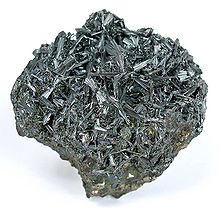| Hutchinsonite | |
|---|---|
 Hutchinsonite, from Quiruvilca Mine, Santiago de Chuco Province, Peru. Size: 4.5×4.4×2.2 cm | |
| General | |
| Category | Sulfosalt mineral |
| Formula (repeating unit) | (Tl,Pb)2As5S9 |
| IMA symbol | Hut[1] |
| Strunz classification | 2.HD.45 |
| Crystal system | Orthorhombic |
| Crystal class | Dipyramidal (mmm) H-M symbol: (2/m 2/m 2/m) |
| Space group | Pbca |
| Identification | |
| Color | Red, pink, black |
| Crystal habit | Acicular – cccurs as needle-like crystals |
| Cleavage | {100} good |
| Fracture | Very brittle fracture producing small, conchoidal fragments |
| Mohs scale hardness | 1.5–2 |
| Luster | Sub-metallic |
| Streak | Red |
| Diaphaneity | Subtranslucent to opaque |
| Specific gravity | 4.6 |
| Optical properties | Biaxial (−) |
| Refractive index | nα = 3.078 nβ = 3.176 nγ = 3.188; 2V = 37° |
| Birefringence | δ = 0.110 |
| References | [2][3][4] |
Hutchinsonite is a sulfosalt mineral of thallium, arsenic and lead with formula (Tl,Pb)2As5S9. Hutchinsonite is a rare hydrothermal mineral.
It was first discovered in a sample from Binnental, Switzerland, in 1903 and named after Cambridge mineralogist Arthur Hutchinson, F.R.S. (1866–1937) in 1904.
See also
[edit]References
[edit]- ^ Warr, L.N. (2021). "IMA–CNMNC approved mineral symbols". Mineralogical Magazine. 85 (3): 291–320. Bibcode:2021MinM...85..291W. doi:10.1180/mgm.2021.43. S2CID 235729616.
- ^ Handbook of Mineralogy
- ^ Hutchinsonite at Mindat.org
- ^ Hutchinsonite at Webmineral
Further reading
[edit]- Prior, G. T. (1905). "A New Thallium Mineral". Nature. 71 (1849): 534. Bibcode:1905Natur..71Q.534P. doi:10.1038/071534b0.
- Matsushita, Y.; Takéuchi, Y. (1994). "Refinement of the crystal structure of hutchinsonite, TlPbAs5S9". Zeitschrift für Kristallographie - Crystalline Materials. 209 (6): 475. Bibcode:1994ZK....209..475M. doi:10.1524/zkri.1994.209.6.475.
- Nihon Kessho Gakkaishi. 32: 68. 1990. doi:10.5940/jcrsj.32.Supplement_68 https://doi.org/10.5940%2Fjcrsj.32.Supplement_68.
{{cite journal}}: Missing or empty|title=(help) - Solly, R. H. (1903). "On some Minerals from Binnental, Switzerland". Proceedings of the Cambridge Philosophical Society. 12: 277.
- Solly, R. H. (1905). "On some Minerals from Binnental, Switzerland" (PDF). Mineralogical Magazine: 72–. doi:10.1180/minmag.1905.014.64.03.
- Raber, Thomas; Roth, Philippe (2018). "The Lengenbach Quarry in Switzerland: Classic Locality for Rare Thallium Sulfosalts". Minerals. 8 (9): 409. Bibcode:2018Mine....8..409R. doi:10.3390/min8090409. hdl:20.500.11850/302136.
Well, that’s interesting to know that Psilotum nudum are known as whisk ferns. Psilotum nudum is the commoner species of the two. While the P. flaccidum is a rare species and is found in the tropical islands. Both the species are usually epiphytic in habit and grow upon tree ferns. These species may also be terrestrial and grow in humus or in the crevices of the rocks.
View the detailed Guide of Psilotum nudum: Detailed Study Of Psilotum Nudum (Whisk Fern), Classification, Anatomy, Reproduction